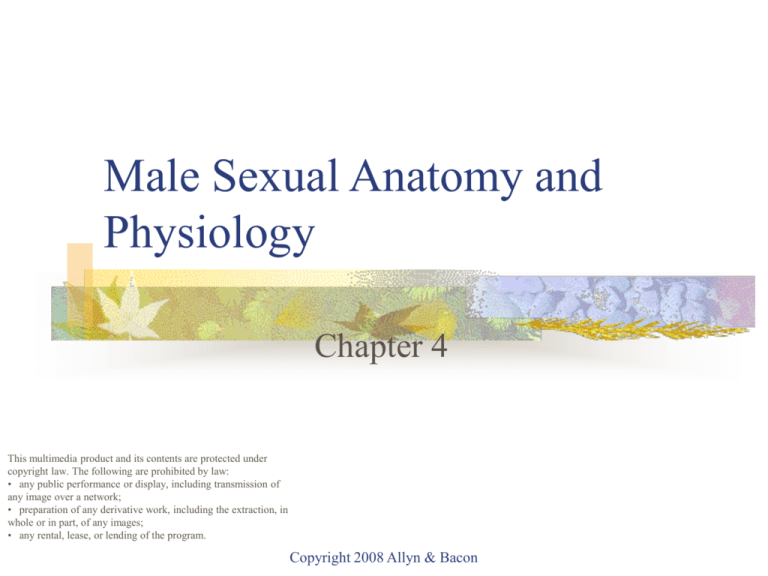
Male Sexual Anatomy and
Physiology
Chapter 4
This multimedia product and its contents are protected under
copyright law. The following are prohibited by law:
• any public performance or display, including transmission of
any image over a network;
• preparation of any derivative work, including the extraction, in
whole or in part, of any images;
• any rental, lease, or lending of the program.
Copyright 2008 Allyn & Bacon
Male Sexual Anatomy and
Physiology
External Sex Organs
Internal Sex Organs
Diseases of the Urogenital System
Male Sexual Functions
Copyright 2008 Allyn & Bacon
External Sex Organs
The Penis
Male organ of sexual intercourse
Serves as a conduit for urine and sperm
Contains cylinders of spongy material
Corpora cavernosa
Spongy tissues that become congested with blood and stiffen
during sexual arousal
Corpus spongiosum
Spongy body that runs along the bottom of the penis
Contains the penile urethra
Enlarges at the tip of the penis to form the glans
Copyright 2008 Allyn & Bacon
External Sex Organs
Glans
Corona
Highly sensitive tip of the penis
Ridge that separates the glans from the body of the
penis
Frenulum
Sensitive strip of tissue that connects the underside
of the penile glans to the shaft
Copyright 2008 Allyn & Bacon
External Sex Organs
Root
Shaft
Base of the penis, which extends into the pelvis
Body of the penis, which expands as a result of
vasocongestion
Foreskin (or prepuce)
Loose skin that covers the penile glans
Circumcision
Surgical removal of the foreskin of the penis
Has religious roots
Becoming less common in the US, as it is no longer
considered medically necessary
Copyright 2008 Allyn & Bacon
External Sex Organs
Copyright 2008 Allyn & Bacon
External Sex Organs
Penis size
Considered a measure of a man’s masculinity
Clinicians report that women in dysfunctional
relationships are less likely to complain about
the size of their partners’ penises than they
are about their partners’ ability to
communicate.
The average erect penis ranges from 5 to 7
inches in length.
Copyright 2008 Allyn & Bacon
External Sex Organs
The Scrotum
Pouch of loose skin that contains the testes
Located beneath the penis
Spermatic cord
Suspends a testicle within the scrotum and contains vas
deferens, blood vessels, nerves, and the cremaster muscle
Cremaster muscle: raises and lowers testes in response to
temperature change
Dartos muscle
Like the cremaster muscle, contracts and relaxes in response to
temperature changes
Increases and decreases the surface area of the scrotum
Copyright 2008 Allyn & Bacon
Internal Sex Organs
Copyright 2008 Allyn & Bacon
Internal Sex Organs
The Testes
Male sex glands, suspended in the scrotum
Produce sperm cells (male germ cells) and
male sex hormones (androgens)
Copyright 2008 Allyn & Bacon
Internal Sex Organs
Testosterone
Male steroid sex hormone
Interstitial cells
Cells that secrete testosterone
Also known as Leydig’s cells
Responsible for prenatal differentiation of male sex
organs
Stimulates the development of secondary sex
characteristics
Traits that distinguish the genders but are not directly involved
in reproduction
Copyright 2008 Allyn & Bacon
Internal Sex Organs
Regulated by
pituitary
hormones
LH stimulates the
secretion of
testosterone
FSH regulates the
production of
sperm
Copyright 2008 Allyn & Bacon
Internal Sex Organs
Sperm
Seminiferous tubules
Tiny, winding, sperm-producing tubes located within the
lobes of the testes
Spermatogenesis
Process by which sperm cells are produced and developed
Spermatocyte
Early stage in the development of sperm cells
Spermatids are cells formed by the division of spermatocytes;
each spermatid has 23 chromosomes.
Spermatozoa are mature sperm cells.
Epididymis: Tube that lies against the back wall of
each testicle and stores sperm
Copyright 2008 Allyn & Bacon
Internal Sex Organs
Passage
of
Spermatozoa
Copyright 2008 Allyn & Bacon
Internal Sex Organs
The Vas Deferens
Tube that conducts sperm from the testicle to
the ejaculatory duct of the penis
Vasectomy
Sterilization procedure in which the vas deferens
is severed
Prevents sperm from reaching the ejaculatory duct
Removes sperm, but not fluids, from ejaculate
Copyright 2008 Allyn & Bacon
Internal Sex Organs
The Seminal Vesicles
Small glands that lie behind the bladder and
secrete fluids that combine with sperm in the
ejaculatory duct
A duct formed by the convergence of a vas
deferens with a seminal vesicle
The fluids produced are rich in nutrients to
help ensure sperm motility.
Copyright 2008 Allyn & Bacon
Internal Sex Organs
The Prostate Gland
Lies beneath the bladder and secretes prostatic fluid,
which gives semen its characteristic odor and texture
Alkaline in fluid neutralizes some of the vaginal
acidity, which prolongs sperm life
Cowper’s Glands
Lie below the prostate and empty their secretions into
the urethra during sexual arousal
Secretion may reduce male acidity and also lubricate
passageway for sperm
Also known as the bulbourethral glands
Copyright 2008 Allyn & Bacon
Internal Sex Organs
Semen
Whitish fluid that constitutes the ejaculate, consisting of
sperm and the fluids secreted by the seminal vesicles, the
prostate gland, and the Cowper’s glands
The seminal vesicles contribute about 70% of the fluid in the
ejaculate.
The remaining 30% consists of sperm and fluids produced by the
prostate gland and the Cowper’s glands.
Sperm make up only about 1% of the ejaculate, but typically it
contains 200-400 million sperm.
Copyright 2008 Allyn & Bacon
Diseases of the Urogenital
System
Urethritis
Inflammation of the bladder or urethra
Cancer of the Testes
Cryptorchidism
Self-examination of the testes
One of two testicles fails to descend from the abdomen into the
scrotum
Affects about 14% of men with testicular cancer
Warning signals are slight enlargement or change in consistency
of a testicle, dull ache in the groin, and sensation of heaviness in
a testicle.
Very high survival rate when detected early
Copyright 2008 Allyn & Bacon
Diseases of the Urogenital System
Disorders of the Prostate
Benign prostatic hyperplasia
Enlargement of the prostate gland due to hormonal
changes associated with aging
Symptoms include frequent and urgent urination, and
difficulty starting the flow of urine
Cancer of the prostate
Second most common form of cancer among men
Second leading cause of cancer deaths in men
Survival rate has improved to 80%
Prostatitis
Inflammation of the prostate gland
Copyright 2008 Allyn & Bacon
Male Sexual Functions
Erection
Engorgement with blood causes the penis to
expand and stiffen
Reverses when blood begins to flow out
Affected by psychological factors
Performance anxiety
Feelings of dread and foreboding experienced in
connection with an activity that might be judged by
others, e.g., sexual activity
Possible throughout the life span
Copyright 2008 Allyn & Bacon
Male Sexual Functions
Spinal Reflexes and Sexual Response
Reflex
Simple, unlearned response to a stimulus that is mediated by
the spine rather than the brain
Responsible for a male’s sexual responses, erection and
ejaculation, regardless of source of stimulation
Role of the spinal cord
Sacrum
Thick, triangular bone located near the bottom of the spinal
column
Center that controls reflexive erections
Copyright 2008 Allyn & Bacon
Male Sexual Functions
Role of the brain
Regulates sexual responses
Sends impulses to the erection center in the upper
back
This center is a relay center between the brain and the penis
and allows perceptual, cognitive, and emotional responses to
contribute to an erection.
When connections between the brain and this center are
inoperable, men fail to achieve erections solely in response
to mental stimulation.
Men require more sexual excitation to achieve full
erection as they age.
Brain can also stifle sexual response
Copyright 2008 Allyn & Bacon
Male Sexual Functions
Role of the autonomic nervous system (ANS)
Division of the nervous system that regulates
automatic bodily responses, such as an erection
Sympathetic
Branch of ANS most active during emotional responses that
spend the body’s energy reserves
Largely controls ejaculation
Parasympathetic
Branch of ANS most active during processes that restore the
body’s energy reserves
Largely controls erection
Copyright 2008 Allyn & Bacon
Male Sexual Functions
Erectile abnormalities
Peyronie’s disease
An abnormal condition characterized by an excessive
curvature of the penis that can make erections painful
Caused by buildup of fibrous tissue in the penile shaft
Most cases require medical attention
Priapism
Erections that persist for hours or days
Causes include leukemia, sickle cell anemia, or diseases of
the spinal cord
Can be dangerous due to loss of oxygen to penile tissues
Copyright 2008 Allyn & Bacon
Male Sexual Functions
Ejaculation
Orgasm
Emission phase
Peak of sexual excitement
Release of sexual tension that builds up during arousal
Not synonymous with ejaculation – one can ejaculate without orgasm
First phase of ejaculation, which involves contractions of the prostate
gland, seminal vesicles, and the upper part of the vas deferens (the
ampulla)
Fluid is propelled into the urethral teact
Expulsion stage
The second stage of ejaculation, during which muscles at the base of
the penis and elsewhere contract, forcing out semen and providing
pleasure
Copyright 2008 Allyn & Bacon
Male Sexual Functions
Retrograde ejaculation
Ejaculate empties into the bladder
Actions of sphincters are reversed such that
the internal bladder sphincter opens
Results in a dry orgasm
Can result in infertility, but otherwise
harmless
Copyright 2008 Allyn & Bacon









